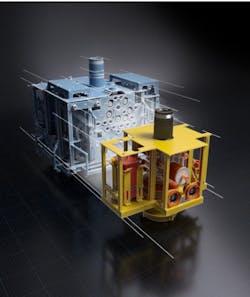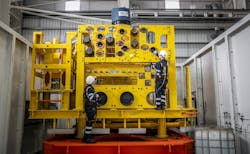Expanded subsea campus aims to propel deepwater technology
Lorenzo Romagnoli, Baker Hughes
Subsea technology is a part of the industry experiencing huge advancements, largely due to the need for infrastructure and equipment that can cope with the increasing challenges of mature basins, ever deepening water, and ever narrower economic margins.
In June 2019, Baker Hughes launched its Subsea Centre of Excellence (CoE) in Montrose on the northeast coast of Scotland. A purpose-built hub of design and manufacturing, it is the result of a £31-million ($40-million) investment by the company, supported by a £4.9-million ($6.3-million) grant from the Scottish government, through Scottish Enterprise.
The CoE has been designed to leverage the best of industry innovation, engineering, manufacturing, test and assembly facilities in the world, all in one place. Created with the specific vision to transform deepwater technology development, it is packed full of some of the most advanced product design and manufacturing equipment the industry has seen.
Factory of the future
The upgraded and expanded CoE was created to encourage product innovation on a new scale. Its systems and products serve the worldwide energy industry mainly in the hydrocarbons segment. To do so, it houses a variety of advanced manufacturing tools and processes, which are there to improve the design and creation of subsea architecture. These tools include:
• Virtual reality systems and digital platforms
• Automated processes, robotics
• Additive manufacturing with 3D printing capabilities
• Laser measurement devices.
In addition, it is the home of the ‘Aptara Design Centre’, dedicated to the development of the Aptara Totex-lite subsea system. This new family of products has been created to support life of field operations, featuring a range of lighter, modular technology solutions re-engineered to enhance production efficiencies and introduce a ‘make-to-order’ concept in the design phase. All of which is coordinated from Montrose.
An enduring model for the future
Following the shift in industry dynamics since 2014, the Baker Hughes team identified a need to, in its own words, “rethink, recalibrate, and reposition the capability of future manufacturing, while finding ways to continue bringing efficiencies to the business and its customers.”
The company’s existing Montrose base already contained machining and manufacturing capability. This was originally created in the region, a few miles south of Aberdeen, due to its strategically important geographic position. It has the benefit of its own local port authority and excellent road links, leading directly to a reduced carbon footprint through reduced transport needs.
When all the factors related to logistics were combined with Scotland’s reputation for engineering capability and expertise, Montrose became the obvious choice to base the new CoE.
In parallel with machinery and digital systems, the 600 strong team of people also formed an intrinsic part of the investment. Indeed, the campus will develop the next generation of the workforce through a series of additional investments, including a dedicated Montrose Learning and Development Centre (MDLC) on site.
The training on offer will also directly support the company’s existing STEM programs, as well as initiatives within local schools. The Apprenticeship intake doubled in 2019 as the center looks to cement its strategically important position in the global energy industry, not only now but over the long term.
Industry 4.0
This sustainable outlook is reinforced by the developments to manufacturing capabilities within the CoE, in particular when it comes to subsea trees. It has the capacity to design, manufacture, and test a complete subsea tree, all under one roof. And not just any tree, for the first time a complete subsea tree system can be built and shipped with the most advanced technology systems in the world.
Production machinery is digitally connected to advanced systems so that data can be downloaded in real time, and then programed to create an optimization algorithm. In turn this enhances the process, making each product in the most efficient and productive way possible.
Taking the impact of digital technology further still, the power of virtual reality has galvanized the technology research and development process. It gives the CoE team the ability to recreate and simulate the assembly procedures of a product, time and time again, with improvements made and elements thoroughly tested in the virtual world at every stage of design.
This means that more than simply testing and assembling trees, the CoE team can simulate the engineering design upfront; continuously optimizing and refining the design and ultimately eliminating defects before the physical assembly of any piece of equipment.
The CoE has further innovated tree manufacturing by introducing additive manufacturing (3D printing) capability for the first time. This was inspired by aviation – an industry that shares a need with the energy industry, to continually evolve to create safe, efficient and technologically advanced components. Because of that, until now, many companies have tried to minimize unscheduled downtime by maintaining large stores of critical spare parts. The process, therefore, allows for simplified manufacturing of components that can reduce costs and enhance performance accelerating the product development through rapid prototyping and shortening the development cycle of oil and gas components, thereby reducing the time it takes to proceed with full production.
The introduction of automation is helping to improve the company’s efficiency on activities like welding, testing and material-handling, i.e. its fully-automated cladding process for tubing hangers and flexible pipe end-fittings improves operator safety, quality, and productivity. Also, recently introduced was the ‘cold metal transfer’, a robot that can improve welding operations, without the need for human intervention. Marking a step forward in the new generation of workplace optimization.
A subsea vision – on land
This, however, seems to just be the start of the story for the CoE. The company plans to continue to develop and invest in its people, technology and products, making the site key for exporting subsea products. In 2020, Baker Hughes will continue to invest in the Montrose center, developing new capability in manufacturing and technology development.
Developing a subsea project today is no mean feat. Mature areas, remote locations, arctic temperatures, high pressure and temperature, and marginal reservoirs mean that every project has its own unique set of challenges.
New infrastructure needs to be more robust than ever before, and requires experience and technology to be able to consistently adapt to everything the industry throws at it. This CoE is not just about manufacturing efficiency, it is about building a sustainable industry through advanced design and manufacturing. Bringing benefits now and well into the future. •


